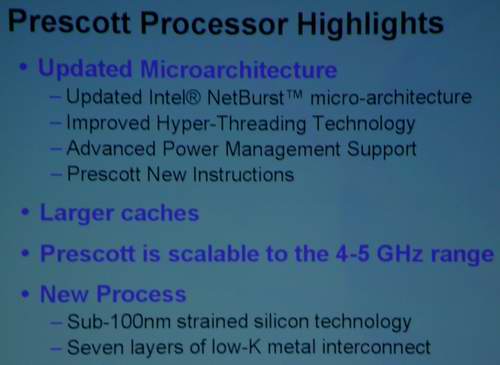Intel's Pentium 4 E: Prescott Arrives with Luggage
by Anand Lal Shimpi & Derek Wilson on February 1, 2004 3:06 PM EST- Posted in
- CPUs
31 Stages: What's this, Baskin Robbins?
Flip back a couple of years and remember the introduction of the Pentium 4 at 1.4 and 1.5GHz. Intel went from a 10-stage pipeline of the Pentium III to a 20-stage pipeline, an increase of 100%. Initially the Pentium 4 at 1.5GHz had a hard time even outperforming the Pentium III at 1GHz, and in some cases was significantly slower.
Fast forward to today and you wouldn't think twice about picking a Pentium 4 2.4C over a Pentium III 1GHz, but back then the decision was not so clear. Does this sound a lot like our CPU design example from before?
The 0.13-micron Northwood Pentium 4 core looked to have a frequency ceiling of around 3.6 - 3.8GHz without going beyond comfortable yield levels. A 90nm shrink, which is what we thought Prescott was originally going to be, would reduce power consumption and allow for even higher clock speeds - but apparently not high enough for Intel's desires.
Intel took the task of a 90nm shrink and complicated it tremendously by performing significant microarchitectural changes to Prescott - extending the basic integer pipeline to 31 stages. The full pipeline (for an integer instruction, fp instructions go through even more stages) will be even longer than 31 stages as that number does not include all of the initial decoding stages of the pipeline. Intel informed us that we should not assume that the initial decoding stages of Prescott (before the first of 31 stages) are identical to Northwood, the changes to the pipeline have been extensive.
The purpose of significantly lengthening the pipeline: to increase clock speed. A year ago at IDF Intel announced that Prescott would be scalable to the 4 - 5GHz range; apparently this massive lengthening of the pipeline was necessary to meet those targets.

Lengthening the pipeline does bring about significant challenges for Intel, because if all they did was lengthen the pipeline then Prescott would be significantly slower than Northwood on a clock for clock basis. Remember that it wasn't until Intel ramped the clock speed of the Pentium 4 up beyond 2.4GHz that it was finally a viable competitor to the shorter pipelined Athlon XP. This time around, Intel doesn't have the luxury of introducing a CPU that is outperformed by its predecessor - the Pentium 4 name would be tarnished once more if a 3.4GHz Prescott couldn't even outperform a 2.4GHz Northwood.
The next several pages will go through some of the architectural enhancements that Intel had to make in order to bring Prescott's performance up to par with Northwood at its introductory clock speed of 3.2GHz. Without these enhancements that we're about to talk about, Prescott would have spelled the end of the Pentium 4 for good.
One quick note about Intel's decision to extend the Pentium 4 pipeline - it isn't an easy thing to do. We're not saying it's the best decision, but obviously Intel's engineers felt so. Unlike GPUs that are generally designed using Hardware Description Languages (HDLs) using pre-designed logic gates and cells, CPUs like the Pentium 4 and Athlon 64 are largely designed by hand. This sort of hand-tuned design is why a Pentium 4, with far fewer pipeline stages, can run at multiple-GHz while a Radeon 9800 Pro is limited to a few hundred-MHz. It would be impossible to put the amount of design effort making a CPU takes into a GPU and still meet 6 month cycles.
What is the point of all of this? Despite the conspiracy theorist view on the topic, a 31-stage Prescott pipeline was a calculated move by Intel and not a last-minute resort. Whatever their underlying motives for the move, Prescott's design would have had to have been decided on at least 1 - 2 years ago in order to launch today (realistically around 3 years if you're talking about not rushing the design/testing/manufacturing process). The idea of "adding a few more stages" to the Pentium 4 pipeline at the last minute is not possible, simply because it isn't the number of stages that will allow you to reach a higher clock speed - but the fine hand tuning that must go into making sure that your slowest stage is as fast as possible. It's a long and drawn out process and both AMD and Intel are quite good at it, but it still takes a significant amount of time. Designing a CPU is much, much different than designing a GPU. This isn't to say that Intel made the right decision back then, it's just to say that Prescott wasn't a panicked move - it was a calculated one.
We'll let the benchmarks and future scalability decide whether it was a good move, but for now let's look at the mammoth task Intel brought upon themselves: making an already long pipeline even longer, and keeping it full.










104 Comments
View All Comments
ianwhthse - Sunday, February 1, 2004 - link
*sigh*Well, now I know.
*goes to buy A64*
KristopherKubicki - Sunday, February 1, 2004 - link
read the article...Stlr22 - Sunday, February 1, 2004 - link
31 stage pipeline?!.....lol..guess those "30 stage pipelne" rumors were true.These processors aren't bad at all. They performed on the same level as the Northwood versions. They just aren't worth the "premium" price tag that they will carry for now.
Looks like there wont be a better time to grab a Northwwod,
as I'm sure these puppies will keep dropping in price to make room for the Prescotts.
Thatguy97 - Wednesday, April 29, 2015 - link
lol never even made to 4ghz man you guys did not give intel the crap it deserved